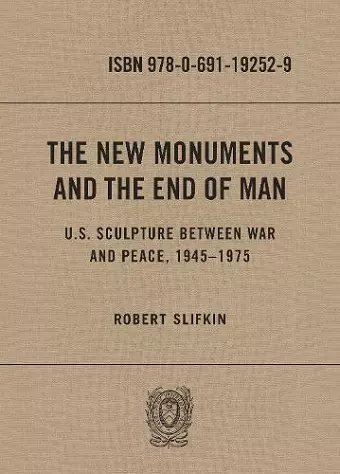The New Monuments and the End of Man
U.S. Sculpture between War and Peace, 1945–1975
Format:Hardback
Publisher:Princeton University Press
Published:17th Sep '19
Currently unavailable, and unfortunately no date known when it will be back

How leading American artists reflected on the fate of humanity in the nuclear era through monumental sculpture
In the wake of the atomic bombings of Japan in 1945, artists in the United States began to question what it meant to create a work of art in a world where humanity could be rendered extinct by its own hand. The New Monuments and the End of Man examines how some of the most important artists of postwar America revived the neglected tradition of the sculptural monument as a way to grapple with the cultural and existential anxieties surrounding the threat of nuclear annihilation.
Robert Slifkin looks at such iconic works as the industrially evocative welded steel sculptures of David Smith, the austere structures of Donald Judd, and the desolate yet picturesque earthworks of Robert Smithson. Transforming how we understand this crucial moment in American art, he traces the intersections of postwar sculptural practice with cybernetic theory, science-fiction cinema and literature, and the political debates surrounding nuclear warfare. Slifkin identifies previously unrecognized affinities of the sculpture of the 1940s and 1950s with the minimalism and land art of the 1960s and 1970s, and acknowledges the important contributions of postwar artists who have been marginalized until now, such as Raoul Hague, Peter Grippe, and Robert Mallary.
Strikingly illustrated throughout, The New Monuments and the End of Man spans the decades from Hiroshima to the Fall of Saigon, when the atomic bomb cast its shadow over American art.
"In an ambitious and compelling interpretation of sculpture between the end of WW II and the end of the Vietnam War, Slifkin (Institute of Fine Arts, NYU) examines the expansion of sculptural aesthetic properties, giving renewed attention to the property of monumentalism. Illuminating work ranging from abstract expressionism to land art, the author looks at this work as sharing a sculptural material presence that acknowledged the 'contemporary space and time of the viewer,' and in so doing offered images of a future Utopian or catastrophic in tone." * Choice *
"A tour de force of social art history, following American sculpture’s mediation of Cold War anxieties until the end of the Nixon era."---David W. Norman, Art History
ISBN: 9780691192529
Dimensions: unknown
Weight: unknown
248 pages